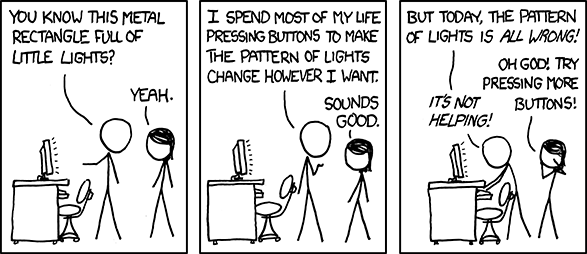# Wrap-up
The last four exercises that make up {ref}`advanced exercises` and {ref}`expert exercises`
are difficult. I chose those tasks because they represent the typical kind
of work that I find myself doing whenever I use ROOT: pulling together
documentation from different places, translating the examples into the
work I'm actually doing... and pounding my head against the desk
whenever there are no comments, or I get yet another segmentation
fault.[^f148]
If you'd like to see how I solved those exercises, you'll find my
code in PlotGraphs.C (for exercises 12-14) and MakeNtuple.C (for
exercise 15).[^f149]
Good luck![^f150]
:::{figure-md} computer_problems-fig
:align: center
 by Randall Munroe
:::
[^f148]: Now you know the reason for my going bald!
[^f149]: Maybe you're thinking, "Wow! It's lucky I went to the end
before I started doing any of this stuff!" Take my word
for it: reading my solutions is not a substitute for working through
the problem yourself.
For example, I wrote those solutions in the mid-2000s. Since then there
have been improvements in ROOT, C++, and Python. You can do better
than I did!
[^f150]: Total lifetimes used up: up to ten, depending on if you chose to
learn both ROOT/C++ and pyroot, which tangents you took, how much
LaTeX you learn, if you read the {ref}`section on statistics `, and whether
you choose a career in physics. I generously give any remaining
lives back to you.
by Randall Munroe
:::
[^f148]: Now you know the reason for my going bald!
[^f149]: Maybe you're thinking, "Wow! It's lucky I went to the end
before I started doing any of this stuff!" Take my word
for it: reading my solutions is not a substitute for working through
the problem yourself.
For example, I wrote those solutions in the mid-2000s. Since then there
have been improvements in ROOT, C++, and Python. You can do better
than I did!
[^f150]: Total lifetimes used up: up to ten, depending on if you chose to
learn both ROOT/C++ and pyroot, which tangents you took, how much
LaTeX you learn, if you read the {ref}`section on statistics `, and whether
you choose a career in physics. I generously give any remaining
lives back to you.
